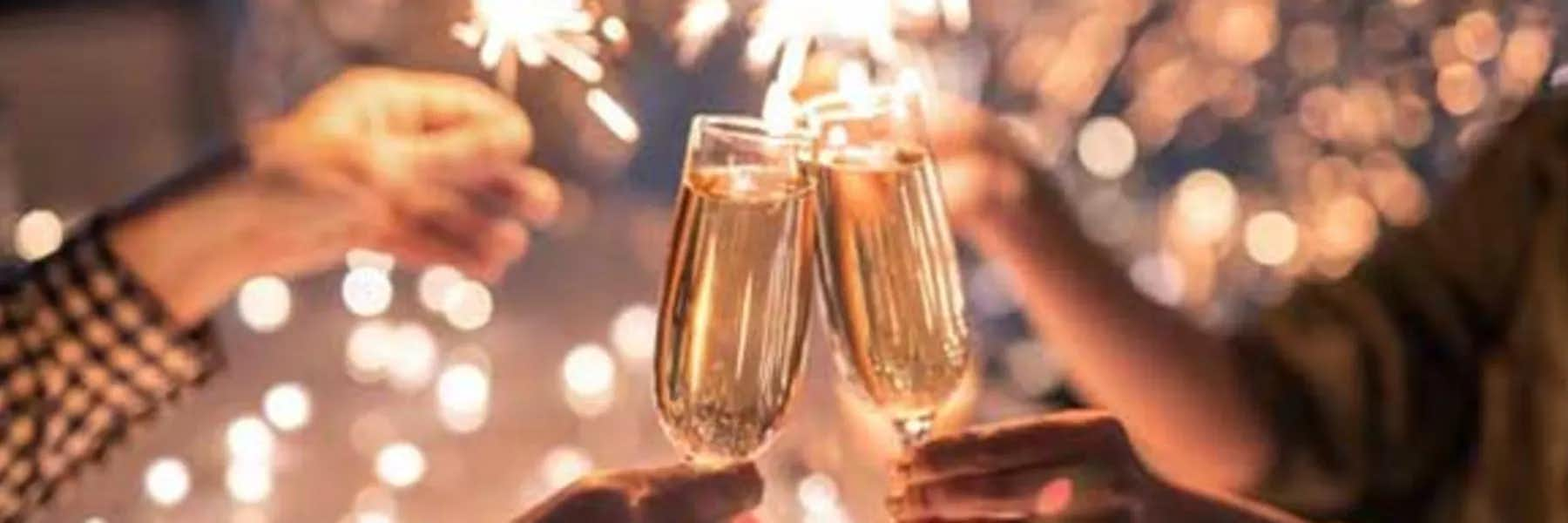Celebrating New Year’s in France

By Tuula Rampont
While Christmas is spent with family, eating any number of wonderful French dishes, New Year’s Eve (known as the reveillon) is set aside for celebrations with friends. For the young among us, or young at heart, NYE festivities might include a road trip to Paris to watch the countdown on the Champs-Elysées. Indeed, ringing in the start to the year is not taken lightly in France. You may have just carved up a turkey in your favorite Christmas sweater surrounded by your immediate family, but a New Year’s celebration calls for going all out.
There’s even an expression in French (which you can use all year long) to describe someone who has pulled out all the stops for the evening: “Se mettre sur son 31”—which means to put on your most elegant clothes as if it were December 31.
Starting at the end of November, you’ll find a concerted effort underway to remind you to buy Champagne. You can’t escape the cartons of the bubbly stuff, and elegant gift boxes filled with your favorite wines, which line the entryways of local supermarkets. It’s hard to pass up the deals.
Whether you’re going low-budget and picking up a $15 bottle or deciding to splash out at $28, Champagne is actually quite affordable when you’re purchasing it in its “home country” and New Year’s is the biggest buying period of the year. Many supermarkets also offer cashback incentives as further enticements. For example, with every $56 spent on Champagne, wine, or spirits, big box stores will offer you a voucher of $11 to use on your next shopping trip.
As for the meal itself, the sky’s the limit. A few will choose to spend the evening at their favorite restaurant, but most folks will celebrate at home with a carefully selected menu. Turkey and small game birds may find their way onto the menu, but seafood—in its many forms—is the top contender. A traditional opener is oysters and Champagne, with lobster, langoustine (jumbo shrimp), and scallops coming in as favorites for the main dish. Dinner is followed by the traditional cheese and salad course, and your host may make a fancy dessert or pick up a sampling of pastries.
At this type of low-key house party, guests will sip their after-dinner drinks while watching a traditional French-style variety show. A mix of everything from colorful can-can dancers to Cirque de Soleil-type acrobatics and magicians pulling would-be rabbits out of hats, it’s just the kind of lighthearted, silly fun you’d expect from the French.
Coming up on midnight, the action switches to the Champs-Elysées where the official NYE countdown begins. A light and sound production is projected onto L'Arc de Triomphe which features 3D-like images celebrating the year gone by, elements of French culture (cyclists whizzing by on the Tour de France, for example,) and a final fireworks display. If you’re looking for all the pomp and majesty Paris has to offer, you won’t be disappointed by this spectacular show.
Get Your Free France Report Here
Get Your Free France Report Here
Learn more about France and other countries in our daily postcard e-letter. Simply enter your email address below and we’ll send you a FREE REPORT: A Taste of France: All the Ingredients for the Good Life.

By submitting your email address, you will receive a free subscription to IL Postcards and special offers from International Living and our affiliates. You can unsubscribe at any time, and we encourage you to read more about our Privacy Policy.
Ringing in the New Year in Portugal

By Terry Coles
People around the world ring in the new year with time-honored traditions, celebrations with friends, and the hopes of a happier, healthier, and more prosperous year to come. The Portuguese love a good party so of course, the new year is welcomed with a bang.
Throughout the country, hotels and restaurants offer celebrations of food, drinks, and accommodations that extend into the wee hours of the morning. Music and merriment can be heard from almost every home while traditions are carried out to ensure success in the new year.
Street parties with food, alcohol, festivities, and music and held throughout the country that end with fireworks at midnight.
Some of the Portuguese traditions center around o dinheiro (money), and how to attract more. Eating chocolate could help, and since chocolate is never a bad thing, why not? Or try holding paper money while stepping up onto a chair, right foot first. This is said to attract richness by stepping up into the world, a symbolic climbing up the ladder of success. Try tossing a coin into the air while hopping on your right foot at midnight for the same reason.
To promote good health and vitality, sipping sparkling wine or champagne at midnight is a must. Be sure to eat twelve raisins as the clock strikes twelve, and make twelve wishes at the same time. Then if you dare—with that same glass of champagne in hand—try jumping up and down again on your right foot while tossing the liquid over your shoulder. Be sure to only look forward and never back, a sign of looking to the future and tossing away all that was bad. And if you happen to splash that champagne on someone behind you, not to worry as it bestows on them, boa sorte (good luck).
What you wear to celebrate the new year can help also, according to Portuguese tradition. Hoping to find love in the new year? Then wear red. If you need more luck, try wearing blue. Wear yellow to attract money, white for peace, green for health, or brown for career enhancement. Clothes should never fit too tight or be riddled with holes or tears, a sure sign of economic troubles in the coming year.
At midnight the young and young at heart enjoy banging pots and pans together to make noise while fireworks light up the dark skies everywhere. The tradition of making noise is one of the oldest, dating back to Roman times, and is said to scare away evil spirits.
With over 600,000 expats living in Portugal full-time there is no shortage of people to gather with to help celebrate the new year. Whether you head to a big city celebration in Lisbon or Porto, or enjoy a smaller coastal town celebration like the one in Quarteira, there are many amazing ways to celebrate a noite do Ano Novo, better known as New Year’s Eve.
Get Your Free Portugal Report Today!
Get Your Free Portugal Report Today!
Discover why we love a slower pace of life in Portugal and info on other European countries in our daily postcard e-letter. Simply enter your email address below and we’ll send you a FREE REPORT – Explore the Old World in Laidback Portugal.

By submitting your email address, you will receive a free subscription to IL Postcards and special offers from International Living and our affiliates. You can unsubscribe at any time, and we encourage you to read more about our Privacy Policy.
New Year's in Germany: From the Perspective of an American Expat

By Erik Meyers
Even though I've been living in Germany for over 20 years, there are still some New Year's traditions here that surprise and amuse me over and over.
Here are my top three favorites.
1. Personal Fireworks
While some towns and cities set off their own fireworks, it is a tradition that pretty much everyone buys small rockets or other small fireworks to set up in their backyard, or on the street in front of their house starting at midnight (though there are always people who "practice" setting them off at say 2 in the afternoon, slightly earlier, and those that "use them up" on January 1 or 2).
Yes, this can get dangerous. I was in Heidelberg once for New Year's Eve (in German: Silvester) and we all stood on a narrow Medieval street as our host set off some of the fireworks he had bought. I froze as one of the rockets headed straight toward me instead of up. Luckily I was able to jump out of the way in time and the rocket hit the stone wall and stopped.
Most of the time, though, this is a loud and fun 30 minutes or more of tons of fireworks being set off. You are surrounded by lights and sounds and booms. Many people watch from a balcony or porch or rooftop to try and see as many as possible.
2. Raclette
Many families have age-old traditions of what to serve on New Year's Eve, but one thing a lot of people make here is Raclette. It is easy to make for a ton of people, because everyone cooks their own food. A tabletop grill is set up on the table with a grill plate on top and spots under the grill for small trays. Each person grills their meat or other food, then places some vegetables topped with cheese underneath to melt the cheese to a bubbling crisp. There is dish upon dish of things to choose from, along with numerous sauces to accompany the food. Always a lot of fun.
3. Dinner for One
As I've been told many times, New Year's is not New Year's in Germany unless everyone watches the comedy sketch "Dinner for One". Though it is in British English, few Brits know about it, but it has somehow become a thing in Germany. The version that is shown every year was recorded by a German TV station in 1962.
In short, a wealthy elderly matron Miss Sophie hosts a dinner party for her 90th birthday. As everyone has gotten on in age, she is the only one left for the apparently annual tradition. Her butler, James, serves the food but also pretends to be each guest for the toast that is required with each course. As the meal proceeds, James has had a lot to drink on an empty stomach. You can imagine the rest.
Maybe it's because I'm not German, but I just have never found it that funny. However, if you are ever in Germany on New Year's Eve, you will certainly be required to take part.
Get Your Free Report on the World's Best Places to Retire in 2025
Get Your Free Report on the World's Best Places to Retire in 2025
Simply enter your email address below to sign up for our free daily postcard e-letter and we'll also send you a FREE report on The World's Top 10 Retirement Havens for 2025.

By submitting your email address, you will receive a free subscription to IL Postcards and special offers from International Living and our affiliates. You can unsubscribe at any time, and we encourage you to read more about our Privacy Policy.
Spain’s New Year’s Traditions

By Marsha Scarbrough
In Spain, Spaniards celebrate non-stop for nearly 48 hours from New Year’s Eve (“nochevieja” which literally translates as “old night”) through New Year’s Day (“año nuevo” which means “new year.”)
The day of December 31 is dedicated to foot races in honor of San Silvestre, the Roman Catholic saint whose feast day falls on New Year’s Eve. Over 200 such 10Ks are run in Spain, but the most famous is San Silvestre Vallecana where 40,000 runners pour through the streets of Madrid and cross the finish line in the stadium of the community of Vallecas, on the outskirts of the city. In 2021, entrants will have the choice of running the physical race in Madrid or running virtually with an official app…or both!
Evening festivities start with a family dinner which ends around 11 p.m. In the next hour, celebrants toast with Cava, Spain’s version of champagne. Putting a gold coin or ring in the bottom of the glass brings more wealth in the year to come. Those seeking love wear red underwear to greet the New Year.
As midnight approaches, some families gather around the TV, and others gather in their cities’ main plazas like Puerta del Sol in Madrid or Plaza España in Barcelona. At this point, each person will have 12 grapes in hand. As chimes ring out the last 12 seconds of the year, each person eats one grape at each chime. It’s no easy feat. At midnight, cheeks are bulging. Those who manage to chew and swallow all 12 will have good luck for the whole year. Supermarkets cooperate by selling small seedless grapes in packages of 12 in the days leading up to New Year’s Eve.
After midnight, firecrackers explode everywhere. Around 1 a.m., the parties begin. Private parties called “cotillones” require tickets purchased in advance. For $67 to $112 per person, partygoers enjoy unlimited cocktails, hors d’oeuvres, dancing, and a gift bag with confetti, balloons, party hats, and other festive accouterments in hotels, banquet halls, or even stadiums. The celebrations, which require suits and ties for men, and long dresses for women, continue until 7 a.m. The first dawn of the new year is traditionally toasted with hot chocolate and churros.
January 1 is a quiet day. Everyone sleeps in and nurses their hangovers. Families share a casual lunch of lentils stewed with sausage for more good luck. On this day, “no hay pan y no hay periódicos” (there is no bread, and there are no newspapers). Nearly all businesses are closed, thus no fresh bread is available. However, movies and theaters are open. By late afternoon, families are heading out to take in the latest Disney animated feature, comic book blockbuster, or quirky Almodóvar family drama.
The New Year proceeds calmly for almost a week. Then on January 6, the holiday of Epiphany, the three wise men bring gifts for everyone. On the night of January 5, parades attract throngs of excited families. Children scramble to grab candies thrown by wise-men impersonators from elaborate floats. The cold night is warmed with cups of hot chocolate and the cream-filled, candied-fruit-topped ring cake called “Roscón de Reyes.” The lucky one who gets the piece with the tiny plastic figure of a wise man gets to wear a paper crown.
New Year’s Eve in Montevideo, Uruguay’s Old City

By David Hammond
On New Year’s Eve in Uruguay, many people go out to dinner or a party. At midnight, the change of the year is marked with firework displays, and for some a glass of Champagne.
Except that New Year’s in Uruguay comes in the summer, it’s not much different from a celebration in North America. (Uruguay is in the Southern Hemisphere, where the seasons are opposite.)
However, there is a place where you can find unique New Year's Eve traditions in Uruguay. And that's in Ciudad Vieja, the oldest neighborhood in Uruguay's capital, Montevideo. Which is where I live. Ciudad Vieja is the original site where Montevideo was founded more than 295 years ago. Today, it’s a mixed-use area with lots of office and apartment buildings as well as tourist sights.
Uruguayans are known for their politeness. But for some, courteous conduct is suspended during the afternoon of New Year’s Eve, and a shadow side emerges. It starts when office workers get off early for the day. They cut up the pages of their used-up desk calendars and then throw the pieces out the window, littering the streets. And that's just the start of things.
Next, mischievous people with a second-story vantage point set out to get anyone passing on the sidewalk below wet. In its simplest form, this is achieved by throwing a bucket of water from a window or balcony onto unsuspecting people below. But hoses, squirt guns, and water balloons may also be used.
Besides a water attack from above, it may come at street level, such as people waiting around a blind corner. (One year, I got soaked by a group of young men in a passing car with a pressurized tank and sprayer.)
On the last afternoon of the year, many locals in Ciudad Vieja know what is coming, and they’ll often just laugh if they get wet. But others, such as visiting tourists, are taken by surprise. And I can tell you first hand, no matter how old you are or how you are dressed, the water throwers show no mercy.
Get Your Free Report on the World's Best Places to Retire in 2025
Get Your Free Report on the World's Best Places to Retire in 2025
Simply enter your email address below to sign up for our free daily postcard e-letter and we'll also send you a FREE report on The World's Top 10 Retirement Havens for 2025.

By submitting your email address, you will receive a free subscription to IL Postcards and special offers from International Living and our affiliates. You can unsubscribe at any time, and we encourage you to read more about our Privacy Policy.
New Year’s Eve in Mexico

By Jason Holland
In Mexico, fireworks and firecrackers are very common. Any sort of religious celebration, traditional festival, civic event, national holiday…is invariably accompanied by a fireworks show put on by the local government or a community group…if not plenty of private individuals setting them off as well. It’s something you get used to when you live in Mexico—even when the local church starts setting them off before first light to mark some sort of religious celebration or patron saint day.
But nothing prepared me for my first New Year’s Eve in San Miguel de Allende, a colonial town in the mountains of central Mexico. Our home at the time was set on a hillside just outside the historic centro, and our rooftop terrace offered a panoramic view of the whole town. At midnight on the dot, fireworks were going off from 20 or more locations around town at the same time. What a show—and it went on for about 30 minutes!
But going crazy with fireworks is just one way they ring in the new year in Mexico and usher in a ¡Feliz Año Nuevo! Here are some more traditions for Nochevieja (New Year’s Eve, translated directly as “Old Night) that I’ve come across in Mexico:
This is a custom inherited from Spain—and one exercised with caution. The tradition goes that you eat 12 grapes, one for each chime of the clock as it hits midnight. It can be tricky to get them all down in time, hence, the note of caution. Some say the 12 grapes represent 12 wishes for the new year or perhaps 12 resolutions. I’ve tried this myself. My advice: get seedless grapes, the smallest you can find!
A must-eat dish for a New Year’s Eve meal with family is bacalao, which is dried and salted codfish. Don’t worry, when it is cooked it doesn’t stay dry, and is not too salty. It’s prepared with tomatoes and olives.
This one is a bit risqué… on New Year’s Eve, ladies looking for love should wear red underwear. There are other colors recommended too, depending on the desired outcome. Yellow brings prosperity and happiness, green wealth, and white hope and peace.
If you want to travel in the coming year, one thing you can try is walking around the house, even the neighborhood, with a suitcase.
Ready for a prosperous new year? Toss 12 coins outside the front door of the home. Then use a broom to sweep them back into the house. This quirky little custom is said to bring financial success.
Of course, just like many places around the world, New Year’s Eve can also be quite a party. Many bars, restaurants, and nightclubs in Mexico will host special events with a dinner, music, dancing, and complimentary Champagne for the midnight toast (maybe even grapes!). Usually, the event is ticketed, so make sure to book in advance.
Of course, many expats end up celebrating with friends in various ways. It’s always fun to blend traditions from your home country with those of your adopted home.
Get Your Free Mexico Report Today!
Get Your Free Mexico Report Today!
Learn more about Mexico and other countries in our daily postcard e-letter. Simply enter your email address below and we’ll send you a free special report – Mexico: The Perfect Close-to-Home Retirement Haven.

By submitting your email address, you will receive a free subscription to IL Postcards and special offers from International Living and our affiliates. You can unsubscribe at any time, and we encourage you to read more about our Privacy Policy.
New Year’s in Costa Rica

By Kathleen Evans
Costa Ricans, for the most part, love a good party with family and friends. And you might say that the Christmas/New Year’s week leading up to New Year’s Eve is the granddaddy of them all. The festive season is in full swing and you will find most non-essential business and government offices closed. So, you can expect zero commerce to happen. This is summer break for Costa Ricans. Yes, I realize officially the country lies in the northern hemisphere and December/January is winter. However, in the land of pura vida, dry season is unofficially summertime.
With the kids out of school, many locals pack their holiday tamales, snacks, and coolers of Imperial (the national beer of Costa Rica) and make the trek from San Jose and the central valley mountains to the beaches around the country. And there are many scenic beaches from which to choose. Massive crowds converge on popular beach towns like Playas del Coco, Tamarindo, Jacó, Puerto Viejo, Uvita—but even the smaller beach communities come alive within this pinnacle of “high season”. The local migration converging with foreign tourists from around the world creates serious driving challenges, no room at the inn, and a damn fun party atmosphere.
I have spent a number of NYE’s in my hometown of Tamarindo. I might suggest bringing a pair of earplugs! The name of the game is beach party. Several large corporations sponsor various music stages, VIP lounges, dance floors, and pop-up kiddie parks for the entire family to enjoy the beach activities. And if the crowds on the north end of the beach feel too claustrophobic, the south end offers more space for building sandcastles, playing in the waves, and enjoying BBQs. As dusk rolls into the much-anticipated eve, crowds dine out and parade around town to the bars—where you will hear live music and even livelier chatter. And once again, as the clock draws closer to midnight, the crowds head to the beach for bonfire parties and fireworks that can be seen in every direction. Both amateur and professional shows. Dancing in the streets and a bit of debauchery will take hold until the wee hours.
One of the magical traditions I have found to be different than other places is lighting a wish lantern and sending it off slowly into the sky with your hopes for a better new year. They make biodegradable ones that will not impact the environment. In some places, you will also find an abundance of grapes at the fruit stands. This is another tradition celebrated in places around the country. The supply is for the 12 grapes of good luck. The thought is everyone should hold, and then eat 12 grapes (one for each month) bringing you good luck the
following year. The origins might be from Spain, because grapes are not even a native fruit!
Of course, results may vary (especially during COVID). Pura vida y feliz año nuevo.
Get Your Free Costa Rica Report Here
Get Your Free Costa Rica Report Here
Learn more about Costa Rica and other countries in our daily postcard e-letter. Simply enter your email address below and we’ll send you a FREE REPORT - Explore the Old World in Laidback Costa Rica.

By submitting your email address, you will receive a free subscription to IL Postcards and special offers from International Living and our affiliates. You can unsubscribe at any time, and we encourage you to read more about our Privacy Policy.
Related Articles
5 Great Places to Retire Where it’s Easy to Fit In
